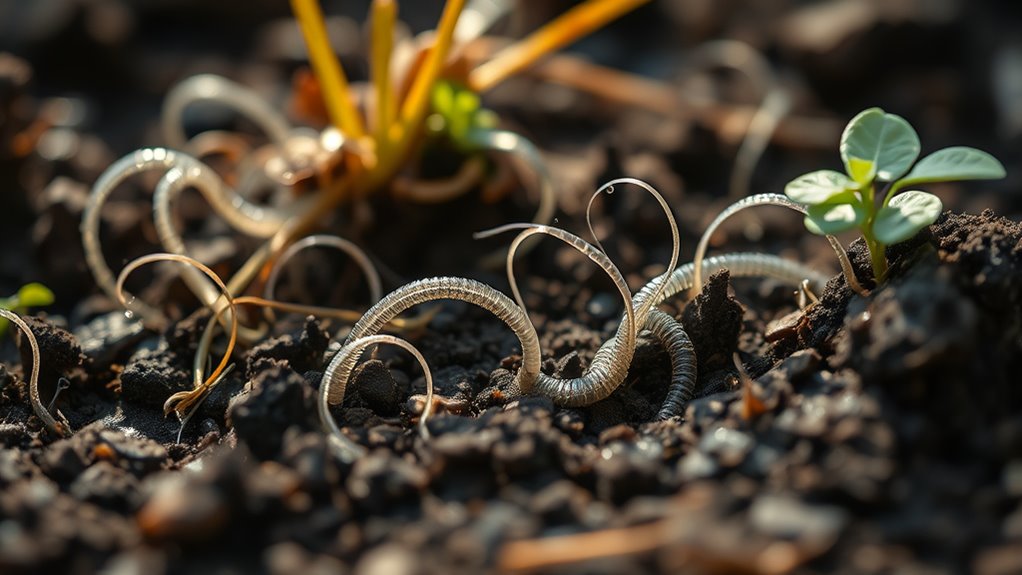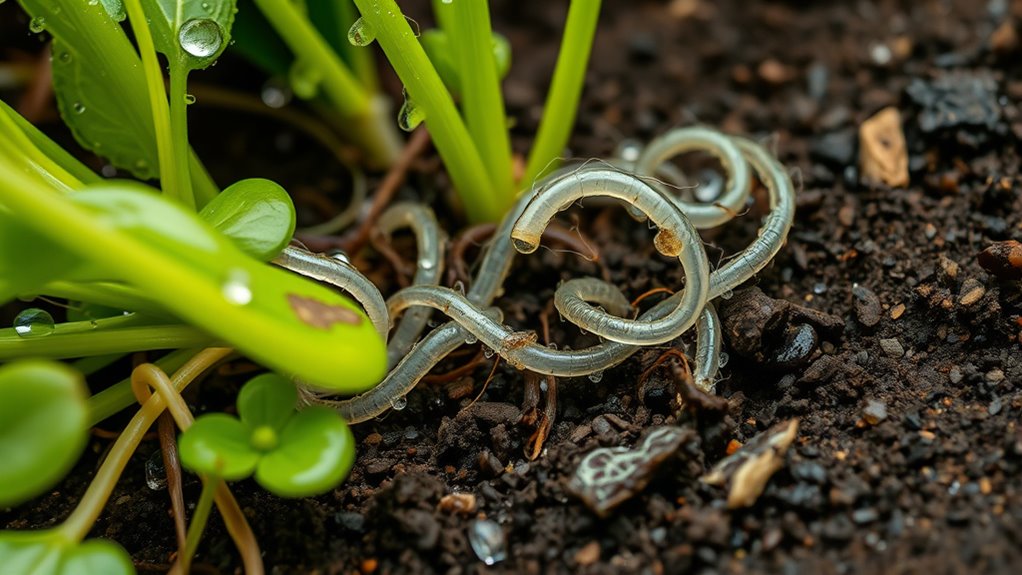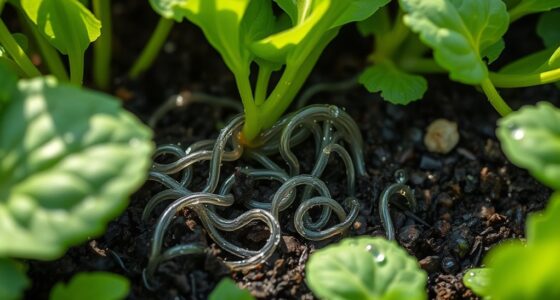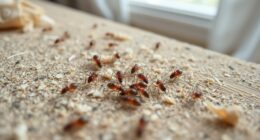Beneficial nematodes are your garden’s microscopic bodyguards, naturally hunting and controlling underground pests like grubs, beetle larvae, and root maggots. They offer an eco-friendly alternative to chemical pesticides, promoting healthy soil and ecosystems. Applying nematodes is simple: mix them with water and apply to moist soil in early morning or evening, then keep the soil moist afterward. To learn how to maximize their effectiveness, stay tuned for more expert tips.
Key Takeaways
- Beneficial nematodes are natural predators that target underground pests like grubs and beetle larvae.
- Apply nematodes in moist soil conditions, ideally during early morning or late evening for maximum effectiveness.
- Reapply after heavy rain or if pests persist; store unused nematodes in the refrigerator to maintain viability.
- Incorporate nematodes into your routine garden care to promote soil health and reduce chemical pesticide use.
- Keep soil moist for at least a week post-application to ensure nematodes effectively control pests underground.

Have you ever heard of beneficial nematodes? These tiny, invisible allies can do wonders for your garden’s soil health and overall pest management. When you introduce beneficial nematodes into your soil, you’re essentially enlisting microscopic bodyguards that target specific pests underground. They are naturally occurring organisms that hunt and kill harmful soil-dwelling insects, like grubs, beetle larvae, and root maggots, helping you maintain a balanced and healthy garden ecosystem. Their presence reduces the need for chemical pesticides, making your garden safer for both your plants and the environment.
Beneficial nematodes are natural predators that protect your garden from underground pests and promote soil health.
Understanding soil health is crucial when considering beneficial nematodes. Healthy soil supports a diverse community of organisms that work together to promote nutrient cycling and plant vitality. When pests become a problem, they can undermine this balance, leading to weakened plants and reduced yields. Beneficial nematodes fit perfectly into this ecosystem because they target pests without harming beneficial insects or soil microbes. To maximize their effectiveness, it’s important to pay attention to nematode application techniques. Proper application ensures that the nematodes reach their target pests effectively and survive long enough to do their job.
Applying beneficial nematodes isn’t complicated, but a few steps can make a big difference. First, always check the soil moisture before application—these nematodes thrive in moist conditions. If your soil is dry, water it thoroughly a day or two before applying them. When it’s time, mix the nematodes with water according to the instructions on the package. Use a sprayer or watering can to distribute the solution evenly across the affected areas. It’s best to apply them in the early morning or late evening when temperatures are cooler and the sun isn’t too intense, as this helps prevent desiccation. After application, keep the soil moist for at least a week to give the nematodes time to establish and hunt down pests.
Consistency is key when using beneficial nematodes. Reapplication may be necessary if pests persist or after heavy rainfall, which can wash them away. Store unused nematodes in a refrigerator until you’re ready to use them—this keeps them viable longer. Remember, the goal is to create an environment where these tiny predators can thrive and do their work efficiently. By integrating proper nematode application techniques into your pest management routine, you’re supporting a healthier, more resilient garden. With patience and care, beneficial nematodes become your garden’s silent but effective guardians against underground pests, helping you grow strong, healthy plants without relying heavily on chemicals.
Frequently Asked Questions
Can Beneficial Nematodes Harm Beneficial Insects in My Garden?
You’re wondering if beneficial nematodes can harm beneficial insects in your garden. Generally, their non-target effects are minimal because of nematode specificity; they target specific pests like grubs or beetles without affecting other insects. Since beneficial insects aren’t part of their target range, they’re safe to use. Just follow application instructions carefully to maximize benefits and avoid any unintended impacts.
How Long Do Beneficial Nematodes Remain Effective After Application?
Beneficial nematodes typically remain effective for about 2 to 4 weeks after application, depending on environmental conditions. The application longevity depends on factors like soil moisture, temperature, and sunlight, which influence their lifespan. To maximize their effectiveness, you should water your garden after applying nematodes and reapply as needed, especially during peak pest activity. Proper care guarantees they stay active longer and continue protecting your garden effectively.
Are Beneficial Nematodes Safe for Pets and Children?
Think of beneficial nematodes as the garden’s gentle security team. You might worry about pet safety and chemical concerns, but these microscopic allies are safe for children and pets—no harsh chemicals involved. I once saw a dog happily play in a yard treated with nematodes, unaware of their presence. They’re a natural, eco-friendly solution that targets pests effectively while keeping your loved ones safe.
What Environmental Conditions Are Best for Nematode Survival?
To guarantee nematodes thrive, you should maintain ideal environmental conditions. Keep soil moisture consistently moist but not waterlogged, as nematodes need moisture to move and survive. The ideal temperature range is between 55°F and 80°F, so avoid extreme heat or cold. Properly managing soil moisture and staying within this temperature window helps nematodes stay active and effective in protecting your garden.
How Often Should I Reapply Beneficial Nematodes for Ongoing Protection?
Reapplication remains key to maintaining your garden’s defenses. For ongoing protection, you should reapply beneficial nematodes every 4 to 6 weeks, depending on soil conditions and pest activity. This application frequency helps sustain nematode longevity, ensuring they stay active and effective against pests. Consistent, scheduled treatments create a cycle of security, safeguarding your garden with persistent pest patrols. Keep reapplying regularly to keep your garden thriving and pest-free!
Conclusion
Now that you’ve brought beneficial nematodes into your garden, imagine tiny, invisible guardians patrolling beneath the soil’s surface. They silently hunt down pests, turning your garden into a fortress of health and vigor. With these microscopic bodyguards at work, you can enjoy lush, thriving plants without harsh chemicals. Watch as your garden transforms into a vibrant, buzzing haven, protected by nature’s own tiny warriors, working tirelessly underground to keep your green space beautiful and pest-free.









